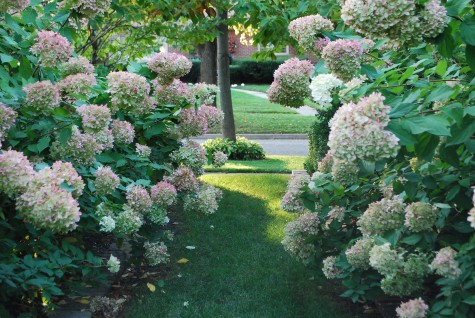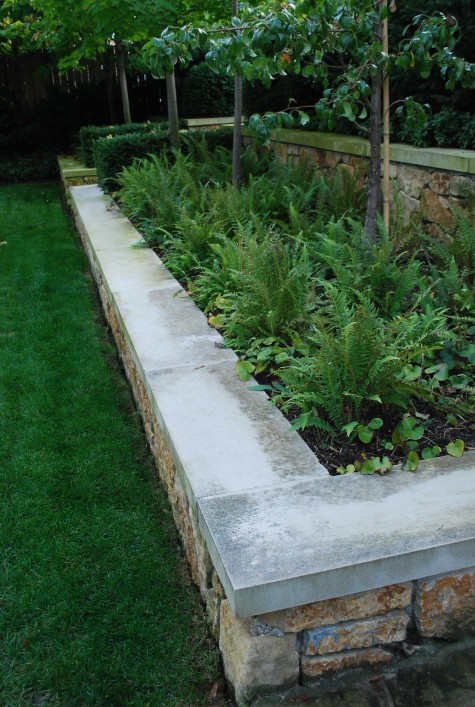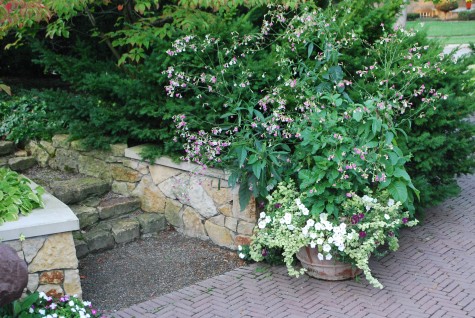 There are those times when the garden has a good day. Good all over. The late day sun slanting across the lawn, and the hydrangeas going pink-just good. I poked my camera lens through the gate for this picture. One of my favorite parts of my garden-I see nothing of the neighbors, and very little of the street. The hydrangeas spilling over the lawn makes it all the more like a garden hideaway.
There are those times when the garden has a good day. Good all over. The late day sun slanting across the lawn, and the hydrangeas going pink-just good. I poked my camera lens through the gate for this picture. One of my favorite parts of my garden-I see nothing of the neighbors, and very little of the street. The hydrangeas spilling over the lawn makes it all the more like a garden hideaway.
 The fountain garden is back to being its serene self-post new drainage work, giant fountain repairs, all new herniaria-and a new bench. I cannot tell this part of my garden was under siege until mid July. Buck is testing the waters already about shutting the fountain down for the winter-I am waving him off.
The fountain garden is back to being its serene self-post new drainage work, giant fountain repairs, all new herniaria-and a new bench. I cannot tell this part of my garden was under siege until mid July. Buck is testing the waters already about shutting the fountain down for the winter-I am waving him off.
 A client that needed a 9 foot long scroll steel bench right away for an event got mine. Though I wasn’t so happy at the prospect of being without a bench until a new one could be made, no doubt I had a chance to tinker with the design. I had the new bench made four inches taller than the original. This is much more comfortable for me, and considerably easier to get in and out of. I had originally planted herniaria under the bench; it was not happy with the shade. A new planting of European ginger seems to be working out fine. This is a better place now.
A client that needed a 9 foot long scroll steel bench right away for an event got mine. Though I wasn’t so happy at the prospect of being without a bench until a new one could be made, no doubt I had a chance to tinker with the design. I had the new bench made four inches taller than the original. This is much more comfortable for me, and considerably easier to get in and out of. I had originally planted herniaria under the bench; it was not happy with the shade. A new planting of European ginger seems to be working out fine. This is a better place now.
 This bed of beech ferns once had Helleborus Angustifolius as a companion. Try as I might, they suffered terribly in the winter. As this species blooms on old stalks, even the bloom period was unsightly. After 5 years I gave them up for European ginger. The planting is lush and thick. I am so glad those gawky hellebores are gone.
This bed of beech ferns once had Helleborus Angustifolius as a companion. Try as I might, they suffered terribly in the winter. As this species blooms on old stalks, even the bloom period was unsightly. After 5 years I gave them up for European ginger. The planting is lush and thick. I am so glad those gawky hellebores are gone.
 The rose garden is much brighter in the evening than the fountain garden; I like walking up into that light. The stone stairs have been in long enough to have acquired a little moss.
The rose garden is much brighter in the evening than the fountain garden; I like walking up into that light. The stone stairs have been in long enough to have acquired a little moss.
 The rose garden is a destination in the evening; a pair of chairs and small table make it a perfect spot to sit and rehash the day. The grass got cut yesterday; the corgis appreciate this. When the grass gets long, they look like they are swimming through it, rather than running over it. I still have intermittent roses; the boltonia and Japanese anemone are in full bloom.
The rose garden is a destination in the evening; a pair of chairs and small table make it a perfect spot to sit and rehash the day. The grass got cut yesterday; the corgis appreciate this. When the grass gets long, they look like they are swimming through it, rather than running over it. I still have intermittent roses; the boltonia and Japanese anemone are in full bloom.
 Japanese anemone is one of my favorite perennials; I like single flowers. I especially like late blooming single flowers. I also like that I do next to nothing to it except look at it. It thrives in this garden for going on ten years now.
Japanese anemone is one of my favorite perennials; I like single flowers. I especially like late blooming single flowers. I also like that I do next to nothing to it except look at it. It thrives in this garden for going on ten years now.
 I pollarded my overgrown Palabin lilacs on standard; it scared me , how hard I cut them back. For weeks, not a peep out of either one of them. They are starting to look good to me.
I pollarded my overgrown Palabin lilacs on standard; it scared me , how hard I cut them back. For weeks, not a peep out of either one of them. They are starting to look good to me.
 I am not sure why this sunken garden has a feeling unique to my garden. It might be the quietest spot in the yard. I am only one block from a 5 lane street. The fountain and the sunken garden minimize that urban noise.
I am not sure why this sunken garden has a feeling unique to my garden. It might be the quietest spot in the yard. I am only one block from a 5 lane street. The fountain and the sunken garden minimize that urban noise.
 On the driveway, the nicotiana mutabilis is still going strong. It will send up giant new shoots all fall long; I keep adding stakes.
On the driveway, the nicotiana mutabilis is still going strong. It will send up giant new shoots all fall long; I keep adding stakes.
 The mum-ball is turning pink-can you hear me sigh? It actually does not look all that bad with the purple kale. The bloom period is actually not that long here-I already have plans to trim it back to a green ball once the flowers fade.
The mum-ball is turning pink-can you hear me sigh? It actually does not look all that bad with the purple kale. The bloom period is actually not that long here-I already have plans to trim it back to a green ball once the flowers fade.

This coleus is done growing; the nights are getting quite cool. Hopefully it will last a while longer. The shape is good. Some days in the garden are just good.









